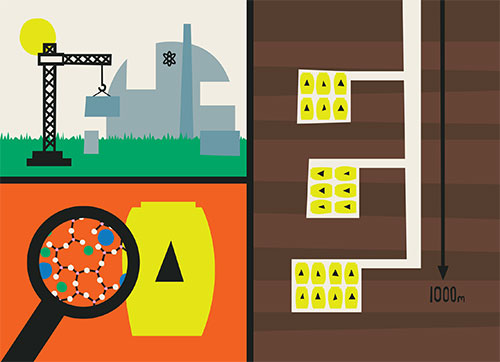Understanding Nuclear "Lava" From Accident Scenarios
Researchers safely probe Chernobyl fuel simulants with x-rays from NSLS-II
March 31, 2021
 enlarge
enlarge
The Immobilization Science Laboratory at the University of Sheffield used NSLS-II to understand the materials science of radioactive waste and the long-term degradation behavior of radioactive waste materials in a geological disposal facility and in the context of nuclear reactor decommissioning. Image credit: Alys Mordecai
The Science
Scientists revealed a detailed chemical analysis of the lava-like fuel-containing materials (LFCMs) found in nuclear reactors after accident scenarios.
The Impact
Understanding the behavior of nuclear fuels in accident scenarios can aid in decommissioning & fuel management at nuclear accident sites. This study offers the first step for more holistic studies of these materials and their chemistry.
Summary
Nuclear disasters, such as the meltdown of the 4th reactor of the Chernobyl Nuclear Power Plant and the incident at the Fukushima Daiichi Nuclear Power Plant have severe consequences. Some of these consequences have lasting effects on the areas due to the large amounts of highly radioactive nuclear fuel-containing materials that are generated during these accidents. These lava-like fuel-containing materials (LFCMs) are a mixture of nuclear fuel and melted reactor components, such as stainless steel and concrete. To effectively and safely decommission and manage these accident sites, it is necessary to understand the nature and chemistry of LFCMs. However, due to their high radioactivity, these materials are very hard to study in most research environments.
In this work, a team of researchers synthesized and characterized a set of LFCM samples with much lower radioactivity. This was achieved by excluding the fission products within the materials. Prior to studying the detailed chemistry of those samples, the researchers verified that their simulant materials were a close approximate of real LFCMs.
To reveal the complex chemistry of their simulant materials, the team used the X-ray Fluorescence Microprobe (XFM) beamline at the National Synchrotron Light Source II (NSLS-II). As a U.S. Department of Energy (DOE) Office of Science User Facility located at DOE’s Brookhaven National Laboratory, NSLS-II offers a wide range of x-ray imaging and microscopy tools such as the XFM beamline.
By combining the various x-ray imaging and chemical analysis tools of XFM, the researchers were able to identify the crystalline phases, determine the local uranium (U) chemistry in crystalline and amorphous phases, and reconstruct the chronology of crystallization of phases from the lava melt, also called paragenetic sequence, of their samples.
These novel insights into the chemistry of nuclear accident materials are key to building a complete understanding of nuclear fuels in incident scenarios. Furthermore, this study shows that these in-depth analyses are possible with extremely small samples, opening a pathway to reducing the risk of studying real nuclear fuel materials drastically.
Download the research summary slide
Related Links
Feature story: “Safely Probing Chernobyl Fuel Simulants with X-rays”
Contact
Claire L. Corkhill
University of Sheffield
c.corkhill@sheffield.ac
Neil C. Hyatt
University of Sheffield
n.c.hyatt@sheffield.ac.uk
Publications
H. Ding, M. C. Dixon Wilkins, C. Gausse, L. M. Mottram, S. Sun, M. C Stennett, D. Grolimund, R. Tappero, S. Nicholas, N. Hyatt, C. L. Corkhill. Safely probing the chemistry of Chernobyl nuclear fuel using micro-focus X-ray analysis. J. Mater. Chem. A (2021) – epub ahead of print. DOI: 10.1039/d0ta09131f
Funding
This work was funded by the UK Engineering and Physical Science Research Council (EPSRC) under grant agreement numbers EP/N017374/1, EP/R01924X/1, EP/S020659/1 and EP/ S01019X/1. MCDW is grateful to the Nuclear Decommissioning Authority for PhD sponsorship. This research utilized the HADES/MIDAS facility at the University of Sheffield established with financial support from EPSRC and BEIS, under grant EP/ T011424/1. We acknowledge the Paul Scherrer Institut, Villigen, Switzerland for provision of synchrotron radiation beamtime at beamline X05 of the SLS and would like to thank Dario Ferreira Sanchez for assistance. This research used beamline 4-BM (XFM) of the National Synchrotron Light Source II, a U.S. Department of Energy (DOE) Office of Science User Facility operated for the DOE Office of Science by Brookhaven National Laboratory under Contract No. DE-SC0012704.
2021-18939 | INT/EXT | Newsroom









